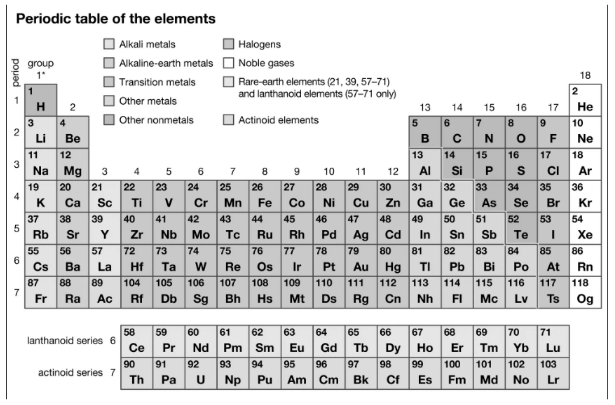Alkaline earth metals, much like alkali metals, are a group of metals that are highly reactive as compared to other elements. They cannot be found in their natural elemental form but in compound form as carbonates or sulphates.
Diagram of the periodic table of the elements

Alkaline earth metals consist of six elements- Beryllium (Be), Magnesium (Mg), Calcium (Ca), Strontium (Sr), Radium (Ra), and Barium (Ba). All the elements in the alkaline earth metal group have a valence configuration of s2, meaning that their outer s-orbital has two electrons that these elements give up in order to form a cation with an electrical charge of +2 alongside a +2 state of oxidation.
Properties of Alkaline Earth Metals
Alkaline earth metals have many other similar properties aside from a common electron valence configuration of s2. They are:
Boiling and Melting Points
Unlike alkali metals, alkaline earth metals do not have a clear pattern of boiling and melting points with respect to their atomic number. Alkali metals see a decrease in boiling and melting point temperatures with an increase in atomic number, but the same cannot be said for alkaline earth metals.
For example, Beryllium (Be) has the lowest atomic number in the group and has the highest melting point at 1287o C. Meanwhile, lithium, which has the lowest atomic number among the alkali metals, has a melting point of 180.5o C.
Throughout the group, there is an uneven pattern of decreasing and increasing boiling and melting points with respect to increasing atomic numbers.
Abundance in Nature
Alkaline earth metals are some of the most abundantly found elements found in nature. Although they cannot be found in their elemental form, there are many substances that have components of various alkaline earth metals.
Magnesium and calcium are some of the most common alkaline earth metals found in nature, being the fifth and eighth most abundant alkaline earth metals, respectively.
Dolomite, carnallite, and magnesite are some of the common minerals containing magnesium. Whereas chalk, gypsum, limestone, and anhydrite are some of the common minerals that contain calcium.
Beryllium is found in the Earth’s crust at a concentration of two to six parts per million, with most of it found in soils at six parts per million.
Strontium is also fairly abundant, with common minerals containing strontium being strontianite and celestite.
Reactivity
All alkaline earth metals react with halogens to form ionic halides, like Calcium Chloride (CaCl2), for example. All alkaline earth metals form ionic halides except for beryllium halides, which are covalent in nature.
Alkaline earth metals barring beryllium, also react with water to produce hydrogen gas and oxygen to form hydroxides. The reactivity of these elements increases as they move from the top of the table to the bottom.
Other Properties of Alkaline Earth metals
Aside from the aforementioned properties, alkali earth metals also share some other similar properties like:
- All alkaline earth metals have a shiny and silvery look.
- All alkaline earth metals have a distinctive flame colour.
- They have low densities and are soft but not as soft and lightweight as alkali metals.
- They also have practical, real-life applications.
Uses of Alkaline Earth Metals
There are many practical applications of alkaline earth metals. Different elements of the group have different uses in our daily lives and also have a biological component to them.
Beryllium
Beryllium has been used as X-ray tubes in hospitals since it lets through more x-rays than glass does. It is also found in emeralds and aquamarines. Aside from this, metal alloys that contain at least 2% beryllium have better resistance against everyday wear and tear, are stronger, and have better stability at higher temperatures.
Calcium
Calcium has been an important part of building structures in the form of limestone and gypsum and is still in popular use today. It is also used in many metal alloys, like aluminium and copper, and is also used for the deoxidation of alloys.
Steel industries use a form of calcium as it helps remove pollutants and other impurities from steel, while calcium carbonate is used in paper industries since it gives a shine to the paper during production.
Calcium is also used in everyday products like toothpaste, vitamin supplements, etc.
Magnesium
Magnesium’s main use is in the production of steel and iron. Its high flammability prevents it from being used at its full capacity, but magnesium still has many real-life applications.
Aside from being used in the production of steel and iron, magnesium also provides better structural strength as compared to materials like aluminium for building construction.
Magnesium also plays a biological role and helps in improving digestion. Along with calcium, magnesium is also consumed as a mineral supplement by many people.
Conclusion
To summarise, alkaline earth metals are highly reactive. They are not found in nature in their elemental form, but some components of alkaline earth metals can usually be found in different substances. They have two electrons in their outermost shell that they give up in order to form a cation. They also have practical, real-life applications in our everyday lives.
 Profile
Profile Settings
Settings Refer your friends
Refer your friends Sign out
Sign out





